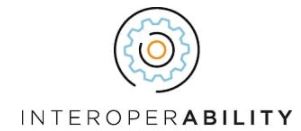
Regardless of size, all school systems benefit from infrastructure modernization. Integral to much-needed modernization efforts is interoperability—the seamless sharing of data, content, and services among systems or applications. Without interoperability, the education sector struggles with the burden of multiple logins, siloed and suspect data, difficulties in student rostering, inaccuracies in data transfer, and unnecessary and costly expenses retrofitting solutions. With it, we have the glue for linking together powerful data across our school districts and empowering educators, students, and parents.
To help districts address the challenges of implementing interoperability, CoSN developed the highly useful Interoperability Toolkit. In addition, CoSN is currently developing an additional resource—the Maturity Model Action Plan. This work is being done in collaboration with the Council of Chief State School Officers (CCSSO) and the Council of Great City Schools (CGCS) with input from the Project Unicorn Steering Committee other organizations. While all the organizations serve different constituencies, all share a common desire to increase interoperability across the education ecosystem.
As CoSN’s CEO Keith Krueger said, “IT Modernization is essential, and interoperability is the glue making it possible.” CoSN and the broader education community are developing a common framework for consistent measurement of interoperability levels by working in collaboration. In addition, standardizing our nomenclature reduces miscommunication. We can foster better communication between organizations and our constituents by agreeing on definitions.
“The Council of Great City Schools is working with the nation’s big-city school districts to develop tools and protocols to improve interoperability,” said the Council’s Executive Director, Raymond C. Hart. “By building structures and best practices to accelerate their progress, we anticipate this project will be beneficial to students across the nation.”
As CCSSO’s Director of Education Data and Information Systems, Dr. Dean Folkers, said, “Interoperability can be a highly technical and complicated subject, but at its core, this work is about ensuring that teachers and parents have the information at their fingertips to support all students. Working together to ensure interoperable solutions for the future is critical.”
This effort also ensures that leading national education organizations are also becoming more interoperable. Our joint efforts to help our members advance interoperability are not happening in silos. Instead, we are becoming a more efficient and effective community by coordinating efforts with methods for “seamless sharing” of feedback.
Author Paula Maylahn


